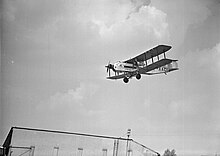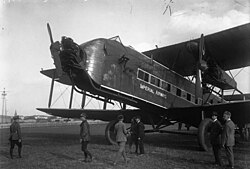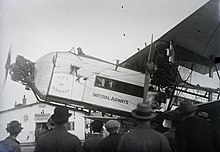
Imperial Airways was an early British commercial long-range airline, operating from 1924 to 1939 and principally serving the British Empire routes to South Africa, India, Australia and the Far East, including Malaya and Hong Kong. Passengers were typically businessmen or colonial administrators, and most flights carried about 20 passengers or fewer. Accidents were frequent: in the first six years, 32 people died in seven incidents. Imperial Airways never achieved the levels of technological innovation of its competitors and was merged into the British Overseas Airways Corporation (BOAC) in 1939. BOAC in turn merged with the British European Airways (BEA) in 1974 to form British Airways.

The Armstrong Whitworth A.W.38 Whitley was a British medium bomber aircraft of the 1930s. It was one of three twin-engined, front line medium bomber types that were in service with the Royal Air Force (RAF) at the outbreak of the Second World War. Alongside the Vickers Wellington and the Handley Page Hampden, the Whitley was developed during the mid-1930s according to Air Ministry Specification B.3/34, which it was subsequently selected to meet. In 1937, the Whitley formally entered into RAF squadron service; it was the first of the three medium bombers to be introduced.
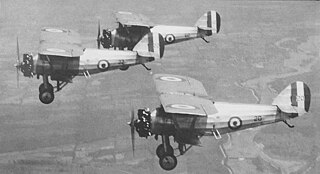
The Armstrong Whitworth Siskin was a sesquiplane single-seat fighter aircraft developed and produced by the British aircraft manufacturer Armstrong Whitworth Aircraft. It was also the first all-metal fighter to be operated by the Royal Air Force (RAF), as well as being one of the first new fighters to enter service following the end of the First World War.

The Rolls-Royce RB.53 Dart is a turboprop engine designed and manufactured by Rolls-Royce Limited. First run in 1946, it powered the Vickers Viscount on its maiden flight in 1948. A flight on July 29 of that year, which carried 14 paying passengers between Northolt and Paris–Le Bourget Airport in a Dart-powered Viscount, was the first regularly scheduled airline flight by a turbine-powered aircraft. The Viscount was the first turboprop-powered aircraft to enter airline service - British European Airways (BEA) in 1953.

The Armstrong Whitworth Argosy was a British post-war transport/cargo aircraft; it was the final aircraft to be designed and produced by aviation company Armstrong Whitworth Aircraft. Although given different internal design numbers, the AW.650 civil and AW.660 military models were, for most practical purposes, the same design, while both models also shared the "Argosy" name.

The Handley Page H.P.42 and H.P.45 were four-engine biplane airliners designed and manufactured by British aviation company Handley Page, based in Radlett, Hertfordshire. It held the distinction of being the largest airliner in regular use in the world upon the type's introduction in 1931.
Sir W. G. Armstrong Whitworth Aircraft Company, or Armstrong Whitworth Aircraft, was a British aircraft manufacturer.

The Armstrong Whitworth A.W.27 Ensign was a British four-engine monoplane airliner and the largest airliner built in Britain during the Interwar period.

The Armstrong Siddeley Jaguar is an aircraft engine developed by Armstrong Siddeley. The Jaguar was a petrol-fuelled air-cooled 14-cylinder two-row radial engine design. The Jaguar III was first used in 1923, followed in 1925 by the Jaguar IV and in 1927 by the Jaguar VI. In 1925 the Jaguar became the first production aero engine incorporating a geared supercharger.

The Handley Page W.8, W.9 and W.10 were British two- and three-engine medium-range biplane airliners designed and built by Handley Page.

The Boulton & Paul P.71A was a 1930s British twin-engined all-metal biplane transport aircraft by Boulton & Paul Ltd used by Imperial Airways for feeder-line work. The P.71 was development of the P.64 Mailplane which had not met the airline's specifications. Two aircraft entered service in early 1935 but both were lost to accidents by end of 1936.

The Airspeed AS.6 Envoy was a twin-engined light transport aircraft designed and produced by the British aircraft manufacturer Airspeed Ltd.

The de Havilland DH.50 was a 1920s British large single-engined biplane transport built by de Havilland at Stag Lane Aerodrome, Edgware, and licence-built in Australia, Belgium, and Czechoslovakia.

The Armstrong Whitworth AW.15 Atalanta was a four-engine airliner designed and produced by the British aircraft manufacturer Sir W.G. Armstrong Whitworth Aircraft Limited at Coventry.

The Hawker Siddeley HS-121 Trident is a British airliner produced by Hawker Siddeley. In 1957, de Havilland proposed its DH.121 trijet design to a British European Airways (BEA) request. By 1960, de Havilland had been acquired by Hawker Siddeley. The Trident's maiden flight happened on 9 January 1962, and it was introduced on 1 April 1964, two months after its main competitor, the Boeing 727. By the end of the programme in 1978, 117 Tridents had been produced. The Trident was withdrawn from service in 1995.
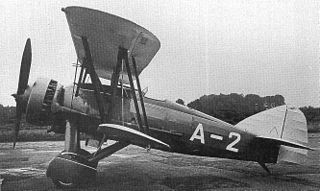
The Armstrong Whitworth A.W.16 was a British single-engine biplane fighter aircraft designed and built by Armstrong Whitworth Aircraft. A number were sold to the Chinese Kwangsi Air Force.

The Armstrong Whitworth A.W.14 Starling was a prototype British single-seat biplane fighter developed for the Royal Air Force in the late 1920s which unsuccessfully competed against the Bristol Bulldog.

The de Havilland DH.34 was a single engined British biplane airliner built by the de Havilland Aircraft Company in the 1920s. 12 were built, with the DH.34 serving with Imperial Airways and its predecessors for several years.
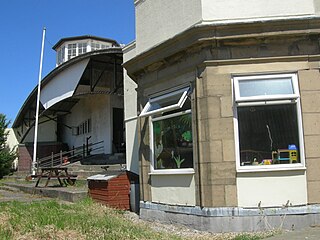
Stanley Park Aerodrome was an airfield located in the Stanley Park area of Blackpool, Lancashire, England. It was also known as Blackpool Municipal Airport, and was in use for civil and military flying from 1929 until closure of the airfield in 1947. The site is now used by Blackpool Zoo.
British Air Transport – The Pioneering Days 1919–1934 is an 8.44-metre (27.7 ft)-long mural by William Kempster depicting, from left to right, a chronological sequence of events in the history of British aviation on the London to Paris route starting on the left with Hounslow Heath Aerodrome in 1919 and finishing on the right at Croydon Aerodrome in 1931. The most recent aircraft shown is the Short L.17 Scylla of 1934.

